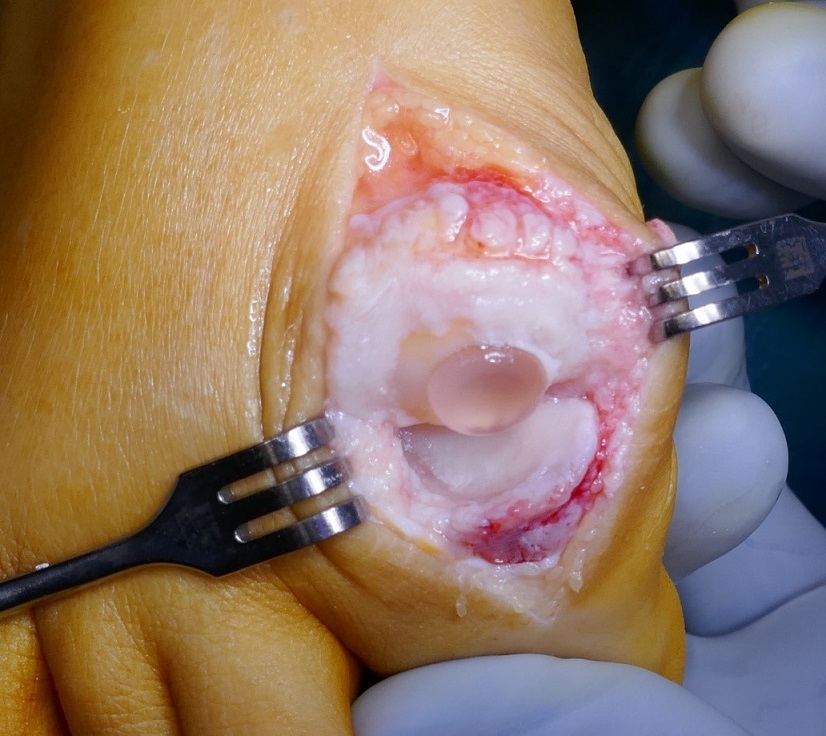Inside This section
HALLUX RIGIDUS
Hallux rigidus literally translated from the Latin means “stiff big toe”.
It is a condition of arthritic change in the first MTP joint. The condition is more common in men than in women with advancing age, though the condition can occur in adolescence.
The condition can be associated with arthropathy such as gout or rheumatoid arthritis but most frequently is associated with osteoarthritis.
Patients complain of pain when pushing off on the great toe. Swelling and stiffness of the great toe are often accompaniments. As with many forms of arthritis, pain is often activity related initially but in the later stages of the disease the pain can occur day and night.
Nonsurgically, the condition can be managed with anti-inflammatory medications, stiffening of the shoe or an insole with an extension beneath the first MTP joint to decrease dorsiflexion. Cortisone injections will give the patients transient relief. The evidence for PRP and stem cells in my opinion does not warrant their use in treatment.

Photograph showing normal first MTP joint and grossly arthritic first MTP joint.
The condition has been classified by Michael Coughlin and it is a useful classification in that it does help with treatment decisions.
In the initial stages of the disease, the patient has normal x-rays and some stiffness in the joint. In the intermediate stages of the disease the patient has no particular pain through the mid range of motion but pain at the extremes of motion with some changes on x-ray involving less than 50% of the joint. The final stage involves pain through the mid range of motion with no articular cartilage left on plain x-rays and frequently an element of deformity.
Nonsurgically, the condition can be managed with anti-inflammatory medications, stiffening of the shoe or an insole with an extension beneath the first MTP joint to decrease dorsiflexion. Cortisone injections will give the patients transient relief. The evidence for PRP and stem cells in my opinion does not warrant their use in treatment.
Obviously activity modification is an important part of management, these patients are frequently runners in their 50s and 60s and I often tell them to go and purchase a bicycle!
Surgical treatment: In the early and intermediate stages of the disease where the patient has no pain through the mid range of motion but pain at the extreme of dorsiflexion a cheilectomy (removal of the lip of bone i.e. the osteophyte) does afford relief in many patients. The operation is straightforward requiring one day in hospital and approximately 7 to 10 days of recovery. Patients report less pain at the extremes of dorsiflexion and in the right patient where the disease is not to advanced the results of surgery are excellent. I explain to patients however that this operation will “buy time” and not be curative in the long-term.
The traditional answer for grade 4 or advanced arthritis was a first MTP joint fusion. A fusion is a good operation in that it does relieve pain. Patients are able to walk, cycle, swim and play tennis. Women are however limited to a 3 cm heel and activities such as yoga which involve bending the great toe are compromised.


A new device has become available known as a “Cartiva”. This is a synthetic material inserted into the metatarsal head as a joint spacer. A randomised controlled trial comparing fusion to Cartiva interestingly in intermediate and advanced grades of arthritis showed “a noninferiority” of the Cartiva compared to fusion at two years. Enthusiasm was therefore great that this was a solution to the patient who wanted to keep their movement.
A recent review however of 64 patients published in the June 2019 edition of Foot and Ankle International showed 38/64 patients were either unsatisfied or very unsatisfied because of ongoing pain and stiffness in the joint. 20 of these patients had had further surgery.
The device is still in use but the results may not be as good as we were first led to believe.
